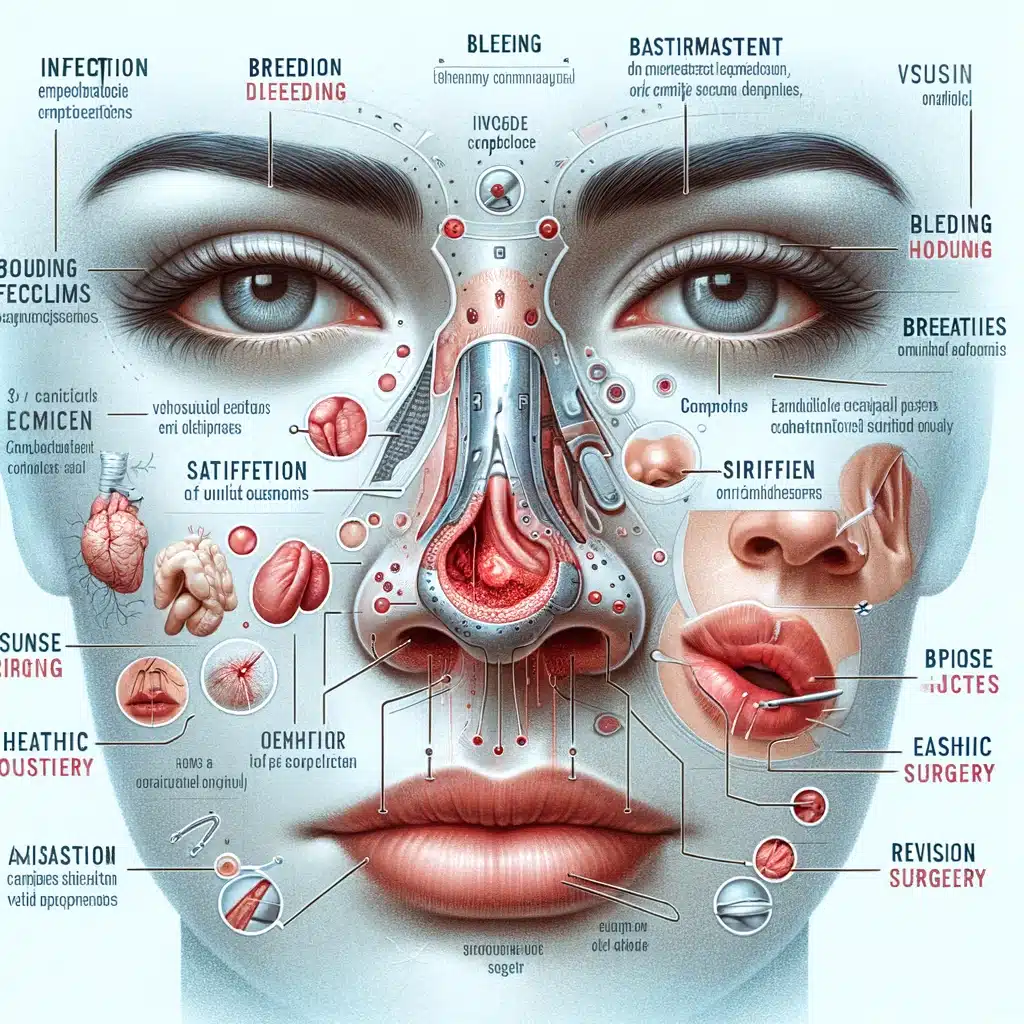Rhinoplasty, while often pursued for aesthetic enhancement, entails inherent risks that extend beyond mere cosmetic concerns. Nasal surgery, synonymous with rhinoplasty, presents potential complications such as septal perforation and nasal valve collapse, which can significantly impact both function and appearance. Understanding these risks is paramount for individuals considering or undergoing rhinoplasty, as they underscore the importance of thorough preoperative assessment and skilled surgical intervention.
Understanding Nose Jobs
The face is often said to be the window to the soul, and the nose, positioned right in its center, plays a pivotal role in determining facial harmony. No wonder many people consider altering its shape or size to enhance their appearance. However, while the allure of a perfectly sculpted nose is tempting, it’s essential to understand the risks of a nose job.
The nose plays a significant role in defining our facial features, and for many individuals, its shape or size may cause self-consciousness or dissatisfaction. Fortunately, advancements in cosmetic surgery have made it possible to alter the appearance of the nose through rhinoplasty, commonly known as a “nose job.”
A nose job, medically known as rhinoplasty, is a surgical procedure to reshape or resize the nose. Whether to correct a deformity, improve breathing, or for purely cosmetic reasons, rhinoplasty is one of the most commonly performed plastic surgeries worldwide.
As with any surgical procedure, the risks of a nose job can vary depending on factors such as the surgeon’s experience, the method employed, and the patient’s health.
Types of Nose Jobs and Their Associated Risks
Several types of nose jobs exist, each with its methodology and purpose:
In the realm of imagination and creativity, a fantasy nose job allows individuals to transform their appearance in extraordinary and unique ways. Whether inspired by mythical creatures, fantastical characters, or personal artistic visions, a fantasy nose job allows one to explore the realms of imagination and bring dreams to life.
- Open Rhinoplasty: Involves an incision along the columella – the tissue separating the nostrils. Though it provides a clearer view of the nose’s anatomy, it also poses risks of a nose job, such as visible scarring.
- Closed Rhinoplasty: Without any external incision, all alterations are done internally. It poses fewer risks of a nose job concerning scarring but might not be apt for intricate surgeries.
- Revision Rhinoplasty: Conducted when an individual has already had a prior nose job and seeks correction or further enhancement. Due to existing scar tissue and the challenges associated with ‘re-operating,’ this often amplifies the risks of a nose job.
- Filler Rhinoplasty: A non-surgical approach using fillers to mold the nose. Though less invasive, it also carries its risks of a nose job, including reactions to the fillers.

Risks of a Nose Job
- Bleeding: Some bleeding is expected, but excessive bleeding can lead to complications.
- Infection: Any surgery poses the risk of infection if not managed correctly.
- Scarring: Especially more prominent in open rhinoplasty.
- Anesthesia complications: Adverse reactions to anesthesia can be severe.
- Difficulty breathing: Altered structures might make breathing difficult.
- Asymmetry: The nose may not heal symmetrically.
- Nasal septal perforation: A hole in the septum which can cause breathing problems or chronic nosebleeds.
- Poor wound healing: Wounds may take longer to heal or not heal properly.
- Numbness: Temporary or permanent loss of sensation in the nasal area.
- Unsatisfactory aesthetic result: The final look might not be as expected.
- Persistent pain: Some patients might experience prolonged pain.
- Swelling: Prolonged or excessive swelling can be an issue.
- Blood clots: Rare but possible.
- Sinusitis: Chronic sinus infections.
- Skin discoloration: Changes in the skin color around the nasal area.
- Nasal obstruction: Blocked nasal passages.
- Cartilage or bone warping: The nose structure might change unfavorably.
- Revision surgery: Needing another surgery due to unsatisfactory results.
- Skin loss: Rarely, skin around the nose might die.
- Ruptured small blood vessels: Visible tiny red spots on the skin.
After the surgery, you need to rest in bed with your head raised higher than your chest. Mayo Clinic
Clinic contact number: +989371200167
Examining the Risks of Nasal Reshaping
The risks of a nose job, or rhinoplasty, have been extensively studied and analyzed by leading institutions such as Johns Hopkins University School of Medicine and Stanford University School of Medicine, where prominent researchers and surgeons have dedicated their careers to advancing the understanding of nasal anatomy and surgical techniques. Within the medical community, Dr. Dean Toriumi, renowned for his contributions to facial plastic surgery, and Dr. Richard Ellenbogen, a pioneer in rhinoplasty and craniofacial surgery, have significantly shaped the field with their expertise and innovative approaches.
Despite advancements in surgical technology and techniques, the complexities of rhinoplasty procedures conducted at institutions like the Mayo Clinic or Massachusetts General Hospital underscore the inherent risks involved. In recent years, the landscape of rhinoplasty has been influenced by the prolific work of companies like Stryker Corporation, which provides cutting-edge surgical instruments and implants tailored for nasal reconstruction procedures.
With an increasing demand for cosmetic enhancement and functional improvement, statistics from the American Society of Plastic Surgeons reveal a steady rise in rhinoplasty procedures performed annually, reaching over 213,000 surgeries in 2022 alone. However, this surge in popularity also correlates with a proportional increase in reported complications, emphasizing the critical importance of meticulous surgical planning and patient selection to mitigate adverse outcomes in the realm of nasal surgery.

Ultra-Popular Non-Surgical Nose Job
Plastic surgery continues to evolve, and that means new, innovative ways to go under the knife. Or not go under the knife at all.
That’s the case with the non-surgical nose job or the liquid nose job, the latest type of plastic surgery to go viral online.
The procedure relies only on needles and fillers, unlike surgical rhinoplasty, which is a more rigorous operation. That’s right, no knives or incisions involved.
It’s not uncommon for social media to draw attention to these kinds of procedures. Just look at the surge in Brazilian Butt Lifts, which was fueled by the rise of influencer culture in 2010, as reported by Vox.
The rising popularity of non-surgical nose jobs — often sought out by women between the ages of 22 and 45, according to double certified body, breast and facial surgeon Dr. Jeffrey G. Lind II — seems to belong to the same reason.
“We are in the selfie age, and people are paying a lot more attention to how they look on camera. Like a lot of cosmetic trends today, social media is the largest driver of the popularity of this procedure,” Dr. Lind II tells PEOPLE.
Non-surgical nose jobs are sought out for aesthetic purposes only and involve injecting derma fillers made of hyaluronic acid — a natural component of the body — into or around the nose.
Dr. Alexander Rivkin — who began practicing the procedure in 2004 and is the founder of RIVKIN Aesthetics as well as an assistant clinical professor at the UCLA School of Medicine — outlines the various appearance-related concerns that the procedure can target.
“The filler can fill depressions, lift the bridge of the nose, camouflage a bump, lift or change the angle of the tip of the nose, restore symmetry and soften post-surgical rhinoplasty irregularities,” Rivkin tells PEOPLE.

Avoid the risks of a Nose Job
- Research your surgeon: Ensure they’re board-certified and experienced.
- Quit smoking: Smoking hampers wound healing.
- Avoid medications: Certain medications can increase bleeding.
- Post-operative care: Follow your surgeon’s advice diligently.
- Keep head elevated: Helps in reducing swelling.
- Avoid strenuous activities: Prevents complications and accelerates healing.
- Stay hydrated: Promotes healing.
- Avoid sun exposure: Protects against discoloration.
- Regular check-ups: Ensure healing is on track.
- Stay informed: Knowledge reduces the risks of a nose job.
Clinic contact number: +989371200167
Food and medications after nise gob
After a nose job (rhinoplasty), it’s essential to follow your surgeon’s post-operative instructions regarding diet and medication to support optimal healing and minimize the risk of complications. In the immediate post-operative period, your surgeon may recommend a soft or liquid diet to ease chewing and minimize strain on the nasal area. This may include foods such as soups, smoothies, yogurt, and mashed potatoes, which are easy to consume and unlikely to irritate the surgical site. It’s also essential to stay hydrated by drinking plenty of fluids, preferably water, to promote healing and prevent dehydration.
Regarding medications, your surgeon may prescribe pain medications to manage discomfort and antibiotics to prevent infection. It’s crucial to take these medications as directed and avoid taking any additional over-the-counter medications without consulting your surgeon first. Non-steroidal anti-inflammatory drugs (NSAIDs) such as ibuprofen should typically be avoided, as they can increase the risk of bleeding. Additionally, herbal supplements, vitamins, and certain medications may interact with anesthesia or affect blood clotting, so it’s essential to disclose all medications and supplements you’re taking to your surgeon before and after surgery. Following your surgeon’s recommendations for diet and medication can help support a smooth recovery and optimal results from your nose job.

The Riskiest parts of the nose job
While all surgical procedures have inherent risks, some parts of rhinoplasty are more delicate and have higher associated risks. Here are a few of the riskiest aspects of the procedure:
Anesthesia
As with any procedure that requires anesthesia, there’s a risk of an adverse reaction to the anesthetic agents, which can lead to complications like breathing difficulties, allergic reactions, and even cardiac arrest in rare instances.
Osteotomy
This is the process of breaking and resetting the nasal bones to reshape the nose. It carries risks of uneven healing, asymmetry, and a “rocker deformity” where the nasal bones move too much.
Altering the Septum
Changing the septum (the cartilage and bone that divides the two nostrils) can inadvertently affect airflow and breathing if not done properly. A very aggressive septal correction can lead to a “saddle nose” deformity, where the nasal bridge collapses.
Tip Surgery
Refining the tip of the nose can be challenging, and there’s a risk of overcorrection, leading to a “pinched” look or asymmetry. There’s also a risk of poor scarring, which can affect the shape and appearance of the tip.
Wound Healing and Scarring
Everyone heals differently, and there’s a risk of poor scarring or delayed healing, leading to noticeable scars, particularly with an “open” rhinoplasty (where an incision is made along the columella, the tissue between the nostrils).
Infection
As with any surgical procedure, there’s a risk of postoperative infection, which can affect healing and the final outcome of the surgery.
Functional Issues
While rhinoplasty often aims to improve the aesthetic appearance of the nose, there’s a risk of impairing the nose’s function. Some patients experience difficulty breathing after the surgery if the internal structures of the nose are not appropriately managed.
To mitigate these risks, choosing a board-certified plastic surgeon or otolaryngologist with extensive experience in rhinoplasty is essential. Preoperative planning, open communication with the surgeon, and careful adherence to postoperative instructions can also help reduce potential complications.
Here are some functional issues associated with these risky areas:
Nasal Valve Area
The nasal valve is a narrow passage responsible for regulating airflow. Alterations to this area during rhinoplasty, such as over-reduction of the nasal tip or excessive narrowing of the nostrils, can lead to nasal valve collapse. This collapse can cause breathing difficulties, nasal congestion, and a sensation of nasal obstruction.
Septum
The nasal septum is the partition between the two nostrils. Damage to the septum during rhinoplasty can result in a deviated septum or septal perforation. A deviated septum can obstruct airflow and cause difficulty breathing, while a septal perforation can lead to whistling sounds during breathing and an increased risk of nasal infections.
Nasal Bridge
Manipulating the nasal bridge, particularly when reducing a dorsal hump, carries risks. Excessive removal of bone or cartilage in this area can weaken the nasal framework, potentially leading to nasal collapse or saddle nose deformity. Such complications can impair nasal breathing and affect the aesthetic appearance of the nose.
Nasal Tip
Reshaping the nasal tip is a critical aspect of rhinoplasty. However, over-reduction or improper reshaping of the nasal tip cartilages can result in issues such as nasal tip drooping, asymmetry, or inadequate nasal projection. These problems can impact both nasal function and aesthetic outcomes.

Summary
In the realm of nasal surgery, including procedures like rhinoplasty, the understanding and management of associated risks are paramount for both patients and surgeons. Septal perforation, nasal valve collapse, and nasal airway compromise are among the potential complications that demand careful consideration due to their impact on both form and function. Additionally, factors such as nasal bleeding and swelling further underscore the complexity of nasal surgery, necessitating meticulous surgical techniques and attentive postoperative care to mitigate adverse outcomes.
To address these risks effectively, surgeons must prioritize patient safety and employ a multidisciplinary approach that integrates advances in surgical technology with a comprehensive understanding of nasal anatomy and physiology. Furthermore, patient education plays a crucial role in managing expectations and fostering informed decision-making regarding nasal surgery. By empowering patients with knowledge about the potential risks and benefits, surgeons can facilitate collaborative decision-making processes that align with patients’ goals and preferences.
Through a combination of diligent preoperative assessment, precise surgical execution, and attentive postoperative management, the risks associated with nasal surgery can be minimized, paving the way for successful outcomes and improved patient satisfaction.
Clinic contact number: +989371200167
FAQs
1. What are the risks of rhinoplasty?
– Rhinoplasty, like any surgical procedure, carries inherent risks and potential complications. These may include infection, bleeding, adverse reactions to anesthesia, scarring, asymmetry, changes in sensation, and dissatisfaction with the aesthetic outcome. It’s essential to discuss these risks with your surgeon and weigh them against the potential benefits before proceeding with surgery.
2. How can I minimize the risks of rhinoplasty?
– Minimizing the risks of rhinoplasty starts with choosing a qualified and experienced surgeon who specializes in facial plastic surgery. Additionally, following pre-operative and post-operative instructions provided by your surgeon, such as avoiding smoking, taking prescribed medications, and attending follow-up appointments, can help reduce the risk of complications. Open and honest communication with your surgeon about your medical history, expectations, and concerns is also crucial for ensuring a safe and successful outcome.
3. Are there specific factors that may increase the risk of complications during rhinoplasty?
– Certain factors, such as underlying medical conditions, smoking, and unrealistic expectations, may increase the risk of complications during rhinoplasty. Patients with medical conditions such as high blood pressure, diabetes, or autoimmune disorders may have a higher risk of surgical complications and should discuss these concerns with their surgeon beforehand. Smoking can impair healing and increase the risk of infection and other complications, so it’s advisable to quit smoking before and after surgery. Unrealistic expectations or poor communication between the patient and surgeon can also lead to dissatisfaction with the results and potential psychological distress.
4. How common are complications from rhinoplasty?
– While complications from rhinoplasty are relatively rare, they can occur in some cases. The likelihood of experiencing complications depends on various factors, including the complexity of the procedure, the skill and experience of the surgeon, and individual patient factors. By choosing a reputable surgeon, carefully following pre-operative and post-operative instructions, and monitoring your recovery closely, you can minimize the risk of complications and increase the likelihood of a successful outcome.
5. What should I do if I experience complications after rhinoplasty?
– If you experience any concerning symptoms or complications after rhinoplasty, such as severe pain, excessive bleeding, difficulty breathing, or signs of infection, it’s crucial to contact your surgeon immediately. Your surgeon can evaluate your condition, provide appropriate treatment, and address any concerns to ensure your safety and well-being throughout the recovery process.
It’s important to remember that while rhinoplasty can achieve significant aesthetic improvements, it is a surgical procedure with potential risks and limitations. By thoroughly researching your options, choosing a qualified surgeon, and actively participating in your pre-operative and post-operative care, you can minimize the risks and increase the likelihood of a successful outcome from rhinoplasty.
Rhinoplasty – Mayo Clinic
https://people.com/what-is-a-non-surgical-nose-job-risks-benefits-7574382



